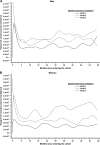Time-dependent association of total serum cholesterol and cancer incidence in a cohort of 172,210 men and women: a prospective 19-year follow-up study
- PMID: 19164459
- PMCID: PMC2685450
- DOI: 10.1093/annonc/mdn736
Time-dependent association of total serum cholesterol and cancer incidence in a cohort of 172,210 men and women: a prospective 19-year follow-up study
Abstract
Background: The relationship between serum cholesterol and cancer incidence remains controversial.
Patients and methods: We investigated the association of total serum cholesterol (TSC) with subsequent cancer incidence in a population-based cohort of 172 210 Austrian adults prospectively followed up for a median of 13.0 years. Cox regression, allowing for time-dependent effects, was used to estimate adjusted hazard ratios (HRs) with 95% confidence intervals (95% CIs) for the association of TSC with cancer.
Results: We observed pronounced short-term associations of TSC and overall cancer incidence in both men and women. For malignancies diagnosed shortly (<5 months) after baseline TSC measurement, the highest TSC tertile (>235.0 mg/dl in men and >229.0 in women) compared with the lowest tertile (<194.0 mg/dl in men and <190.0 in women) was associated with a significantly lower overall cancer risk [HR = 0.58 (95% CI 0.43-0.78, P(trend) = 0.0001) in men, HR = 0.69 (95% CI 0.49-0.99, P(trend) = 0.03) in women]. However, after roughly 5 months from baseline measurement, overall cancer risk was not significantly associated with TSC. The short-term inverse association of TSC with cancer was mainly driven by malignancies of the digestive organs and lymphoid and hematopoietic tissue.
Conclusion: The short-term decrease of cancer risk seen for high levels of TSC may largely capture preclinical effects of cancer on TSC.
Figures
References
-
- Huxley R, Lewington S, Clarke R. Cholesterol, coronary heart disease and stroke: a review of published evidence from observational studies and randomized controlled trials. Semin Vasc Med. 2002;2:315–323. - PubMed
-
- Pearce ML, Dayton S. Incidence of cancer in men on a diet high in polyunsaturated fat. Lancet. 1971;1:464–467. - PubMed
-
- Rose G, Blackburn H, Keys A, et al. Colon cancer and blood cholesterol. Lancet. 1974;1:181–183. - PubMed
-
- Williams RR, Sorlie PD, Feinleib M, et al. Cancer incidence by levels of cholesterol. JAMA. 1981;245:247–252. - PubMed
-
- Stemmerman GN, Nomura AM, Heilbrun LK, et al. Serum cholesterol and colon cancer incidence in Hawaiian Japanese men. J Natl Cancer Inst. 1981;67:1179–1182. - PubMed
Publication types
MeSH terms
Substances
Grants and funding
LinkOut - more resources
Full Text Sources
Medical


